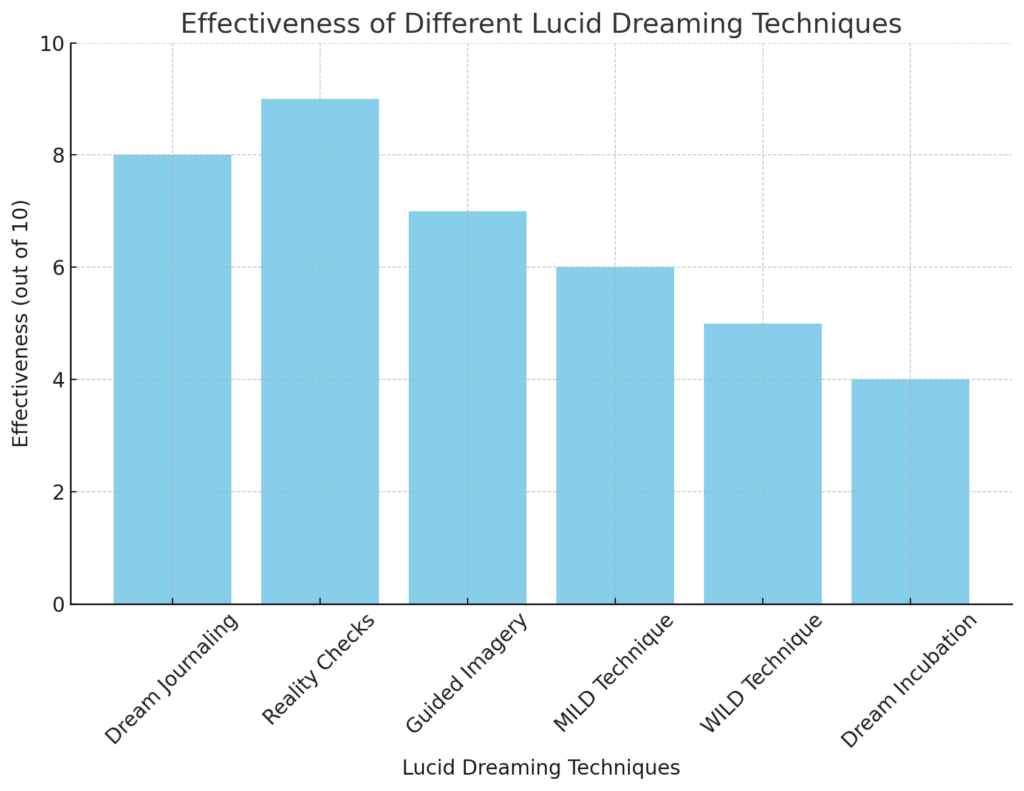Exploring the Safest Methods for Lucid Dreaming: A Comprehensive Guide

Key Takeaways Table
| Key Point | Details |
|---|---|
| Understanding Lucid Dreaming | An overview of what lucid dreaming entails and its benefits. |
| Safe Techniques for Lucid Dreaming | A list of proven, safe methods for inducing lucid dreams. |
| Avoiding Common Mistakes | Guidance on how to avoid common pitfalls in lucid dreaming. |
| The Role of Anxiety in Lucid Dreaming | Examining the impact of anxiety on lucid dreaming experiences. |
| The Connection Between Astral Projection and Lucid Dreaming | Exploring the similarities and differences between these two phenomena. |
Lucid dreaming, a state where the dreamer is aware that they are dreaming and can potentially control the dream’s content, presents a fascinating intersection of sleep and consciousness. It offers a window into the subconscious mind and a platform for exploring inner worlds. This comprehensive guide delves into the safest methods for lucid dreaming, drawing on insights from The Beginner’s Guide to Lucid Dreaming and addressing common concerns such as Lucid Dreaming and Anxiety.

Understanding Lucid Dreaming
Table: Lucid Dreaming Basics
| Aspect | Description |
|---|---|
| Definition | Being consciously aware during a dream. |
| Potential Benefits | Creative problem-solving, overcoming fears, and self-exploration. |
| Frequency | Varies; some may experience naturally, while others may need practice. |
Lucid dreaming is not just a novel experience; it’s a gateway to deeper self-understanding and personal growth. The practice can enhance creative problem-solving, allow for the rehearsal of skills, and provide a unique form of escapism.
Safe Techniques for Lucid Dreaming
1. Dream Journaling
Maintaining a dream journal can significantly increase the likelihood of experiencing lucid dreams. By recording dreams immediately after waking, you enhance dream recall and awareness, crucial for lucid dreaming.
2. Reality Checks
Frequent reality checks throughout the day train the mind to question reality, increasing the chances of doing the same during a dream. Simple actions like reading text or looking at your hands can serve as effective checks.
3. Guided Imagery and Meditation
Meditation and guided imagery before sleep can set the stage for a lucid dream. These practices calm the mind and increase focus, making it easier to enter a state of lucid dreaming.
4. MILD Technique
The MILD (Mnemonic Induction of Lucid Dreams) technique involves waking up after a period of sleep and then going back to sleep while focusing on the intention to remember that you are dreaming.
For more specialized methods, refer to Lucid Dream Techniques.
Avoiding Common Mistakes in Lucid Dreaming
Lucid dreaming, while exciting, can also be challenging. Common pitfalls include trying too hard, which can lead to sleep disturbances, and not maintaining a consistent practice. Reviewing Lucid Dreaming Mistakes can provide valuable insights into avoiding these common errors.
The Role of Anxiety in Lucid Dreaming
Anxiety can play a significant role in the quality and frequency of lucid dreams. Understanding this relationship is key to a positive lucid dreaming experience. The article Mind and Lucid Dreaming: Anxiety offers an in-depth look at this dynamic.
The Connection Between Astral Projection and Lucid Dreaming
Lucid dreaming and astral projection are often spoken of in the same breath, yet they are distinct experiences. Astral projection involves the conscious separation of the astral body from the physical body, venturing into what is perceived as the astral plane. In contrast, lucid dreaming occurs entirely within the dream state. For a more detailed comparison, consider reading about Astral Projection vs Lucid Dreaming.

Comparing and Contrasting
| Aspect | Lucid Dreaming | Astral Projection |
|---|---|---|
| Location | In the mind, within a dream | Believed to be outside the physical body |
| Control Level | High (control over dream environment) | Varies (more about exploration) |
| Awareness | Self-awareness within the dream | Consciousness of separation from the body |
Understanding these differences is crucial for anyone delving into either practice. It helps in setting realistic expectations and preparing appropriately for each experience.
Advanced Lucid Dreaming Techniques
For those who have mastered the basics of lucid dreaming, there are more advanced techniques to explore:
- WILD Technique: Wake Induced Lucid Dreams (WILD) involve transitioning from wakefulness directly into a lucid dream, maintaining consciousness throughout the process.
- Dream Incubation: This technique involves setting an intention or question before sleep, with the aim of receiving answers or insights through your dreams.
These advanced methods require practice and patience. They offer deeper insight and more profound experiences but also come with their own set of challenges.
Lucid Dreaming: A Review of Experiences
Lucid dreaming experiences can vary greatly from person to person. They can range from exhilarating adventures to profound spiritual journeys. For a comprehensive collection of experiences, refer to Lucid Dreaming Review.
Ensuring a Balanced Approach
While exploring lucid dreaming can be enriching, it’s important to maintain a balanced approach. This means not neglecting physical health, mental well-being, and the demands of daily life. Lucid dreaming should complement, not consume, one’s life.

Embracing the Challenges of Lucid Dreaming
Lucid dreaming, while offering a myriad of benefits, is not without its challenges. Novices and experienced dreamers alike may encounter difficulties such as dream instability, where the dream environment changes unpredictably, or false awakenings, where the dreamer believes they have woken up but are actually still dreaming. Tackling these challenges effectively requires patience, practice, and the right mindset. It’s also helpful to refer to resources like Lucid Dreaming Mistakes for common errors to avoid.
Table: Common Lucid Dreaming Challenges and Solutions
| Challenge | Solution |
|---|---|
| Dream Instability | Stabilization techniques like rubbing hands or spinning around. |
| False Awakenings | Regular reality checks, even upon waking. |
| Difficulty in Recall | Maintaining a regular dream journal. |

The Psychological Implications of Lucid Dreaming
The psychological aspects of lucid dreaming are as intriguing as they are complex. Lucid dreaming can provide insights into the subconscious mind, helping in understanding and resolving deep-seated fears, anxieties, and desires. However, it’s crucial to approach these explorations with care, recognizing the boundaries between dream work and reality.
Integrating Lucid Dreaming into Daily Life
Incorporating lucid dreaming into one’s daily routine can enhance self-awareness and creativity. Simple practices like mindfulness during the day can increase the likelihood of lucidity at night. For those new to the practice, starting with Lucid Dreaming for Beginners can offer a solid foundation.
Maximizing the Benefits of Lucid Dreaming
To fully reap the benefits of lucid dreaming, it’s important to approach the practice with intention and awareness. Setting clear goals for your lucid dreams, whether they’re for personal development, creative inspiration, or simply exploration, can provide direction and purpose to your nocturnal adventures.
Table: Goals for Lucid Dreaming and Their Benefits
| Goal | Benefit |
|---|---|
| Overcoming Fears | Facing and resolving fears in a safe, controlled environment. |
| Creative Problem Solving | Utilizing the dream state for innovative thinking and solutions. |
| Personal Growth | Exploring aspects of the self for deeper understanding and growth. |
The Ethical Considerations of Lucid Dreaming
As with any practice that involves the mind and consciousness, ethical considerations are paramount in lucid dreaming. It’s important to respect the integrity of the dream state and avoid using lucid dreaming for escapism or avoidance of real-life responsibilities and challenges.
Continuing Your Journey in Lucid Dreaming
For those interested in continuing their journey in lucid dreaming, a wealth of resources and communities are available. Engaging with forums, reading further literature, and practicing consistently can deepen the experience and understanding of lucid dreaming. Resources such as Lucid Dreaming Techniques can be instrumental in advancing your practice.
Summary and Closing Thoughts on Lucid Dreaming
Lucid dreaming is more than just a fascinating phenomenon; it’s a powerful tool for personal development, self-exploration, and creative expression. This guide has covered the basics of lucid dreaming, safe techniques for inducing lucidity, common challenges and their solutions, and the broader implications and benefits of this practice.

Key Points Recap
- Understanding Lucid Dreaming: Lucid dreaming involves being aware that you’re dreaming and potentially controlling the dream narrative.
- Safe Techniques: Practices like dream journaling, reality checks, and mindfulness meditation are effective and safe ways to induce lucid dreams.
- Challenges and Solutions: Common challenges such as dream instability and false awakenings can be overcome with specific techniques and consistent practice.
- Psychological and Ethical Considerations: Lucid dreaming offers profound psychological insights but requires an ethical and balanced approach.
- Integrating into Daily Life: Incorporating lucid dreaming into your daily routine can enhance creativity and self-awareness.
As you embark on or continue your lucid dreaming journey, remember to approach it with a sense of curiosity, respect, and balance. The world of lucid dreaming is vast and filled with potential for discovery and growth. Whether you’re seeking personal insights, creative inspiration, or simply a unique adventure, lucid dreaming can open the door to a fascinating and deeply rewarding exploration of the mind.
For further reading and resources on this topic, exploring articles such as Lucid Dreaming Review and Mind and Lucid Dreaming: Anxiety can provide additional insights and guidance.
Lucid dreaming is a journey that transcends mere sleep, offering a bridge to the deeper realms of consciousness and self-discovery. Embrace this journey with an open mind and heart, and the experiences you gain can be truly transformative.